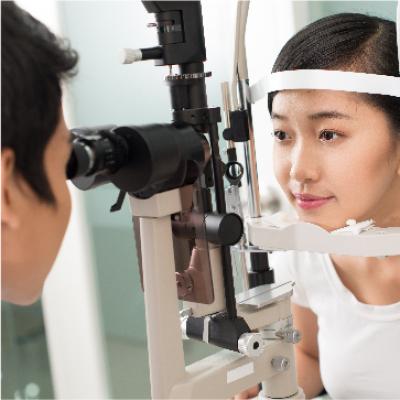Corneal Conditions | National Eye Institute (original) (raw)

At a glance: Corneal Conditions
- Symptoms:
Eye pain, blurry vision, red or watery eyes, sensitivity to light - Treatment:
Medicine, laser surgery, corneal transplant, artificial cornea
What is the cornea?
The cornea is the clear outer layer at the front of the eye. The cornea helps your eye to focus light so you can see clearly.
What are the main types of corneal conditions?
There are several common conditions that affect the cornea.
Injuries. Small abrasions (scratches) on the cornea usually heal on their own. Deeper scratches or other injuries can cause corneal scarring and vision problems.
Allergies. Allergies to pollen can irritate the eyes and cause allergic conjunctivitis (pink eye). This can make your eyes red, itchy, and watery.
Keratitis. Keratitis is inflammation (redness and swelling) of the cornea. Infections related to contact lenses are the most common cause of keratitis.
Dry eye. Dry eye happens when your eyes don’t make enough tears to stay wet. This can be uncomfortable and may cause vision problems.
Corneal dystrophies. Corneal dystrophies cause cloudy vision when material builds up on the cornea. These diseases usually run in families.
There are also a number of less common diseases that can affect the cornea — including ocular herpes, Stevens-Johnson Syndrome, iridocorneal endothelial syndrome, and pterygium.

When to get help right away
Go to the eye doctor or the emergency room if you have:
- Intense eye pain
- Change in vision
- Blurry vision
- Very red, watery eyes
- An object stuck in your eye
- A serious eye injury or trauma — like getting hit hard in the eye
Am I at risk for corneal conditions?
Some corneal conditions, like corneal dystrophies, run in families. But there are steps you can take to lower your risk of corneal injuries and infections.
To prevent corneal injuries, wear protective eyewear when you:
- Play sports that use a ball or puck, like baseball or hockey
- Do yardwork, like mowing the lawn or using a weedwhacker
- Make repairs, like painting or hammering
- Use machines, like sanders or drills
- Use chemicals, like bleach or pesticides
If you wear contact lenses, always follow the instructions to clean, disinfect, and store your lenses. This can help prevent corneal infections, like keratitis.

Feel like something’s stuck in your eye?
- Try blinking several times
- Try rinsing your eye with clean water or saline (salt) solution
- Try pulling your upper eyelid down over your lower eyelid
- Don’t rub your eye — you could scratch your cornea
- If an object is stuck in your eye, don’t try to remove it yourself — go to your eye doctor or the emergency room
How will my eye doctor check for corneal conditions?
Eye doctors can check for corneal conditions as part of a comprehensive eye exam. The exam is simple and painless.
To check for corneal abrasions (scratches), your eye doctor may use a special type of eye drops called fluorescein dye. The dye makes corneal abrasions easier to see.
What is the treatment for corneal conditions?
Many corneal conditions can be treated with prescription eye drops or pills. If you have advanced corneal disease, you may need a different treatment.

Laser treatment. To treat some corneal dystrophies and other conditions, doctors can use a type of laser treatment called phototherapeutic keratectomy (PTK) to reshape the cornea, remove scar tissue, and make vision clearer.
Corneal transplant surgery. If the damage to your cornea can’t be repaired, doctors can remove the damaged part and replace it with healthy corneal tissue from a donor.
Learn more about corneal transplants
Artificial cornea. As an alternative to corneal transplant, doctors can replace a damaged cornea with an artificial cornea, called a keratoprosthesis (KPro).

Did you know?
- Corneal transplants are the most common type of transplant surgery
- In 2014, more than 47,000 people in the United States got a corneal transplant
What is the latest research on corneal conditions?
Scientists are studying what causes corneal disease and how we can find it earlier and treat it better. NEI also funds research on new treatment options.
Last updated: December 11, 2024
